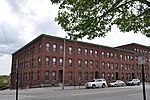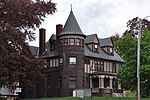Smith and Dow Block
Buildings and structures completed in 1892Buildings and structures in Manchester, New HampshireNational Register of Historic Places in Manchester, New HampshireResidential buildings on the National Register of Historic Places in New HampshireRomanesque Revival architecture in New Hampshire

The Smith and Dow Block is a historic apartment house at 1426-70 Elm Street in Manchester, New Hampshire. When built in 1892, this four-story brick building was the largest apartment block in the state, and it still dominates its section of Elm Street. It has modest Romanesque styling elements, and was designed by William M. Butterfield, one of Manchester's leading architects, as an investment property for John Butler Smith and Frederick C. Dow. The building was listed on the National Register of Historic Places in 2002.
Excerpt from the Wikipedia article Smith and Dow Block (License: CC BY-SA 3.0, Authors, Images).Smith and Dow Block
Dow Street, Manchester
Geographical coordinates (GPS) Address Nearby Places Show on map
Geographical coordinates (GPS)
| Latitude | Longitude |
|---|---|
| N 42.998333333333 ° | E -71.465 ° |
Address
Dow Street 21
03101 Manchester
New Hampshire, United States
Open on Google Maps







